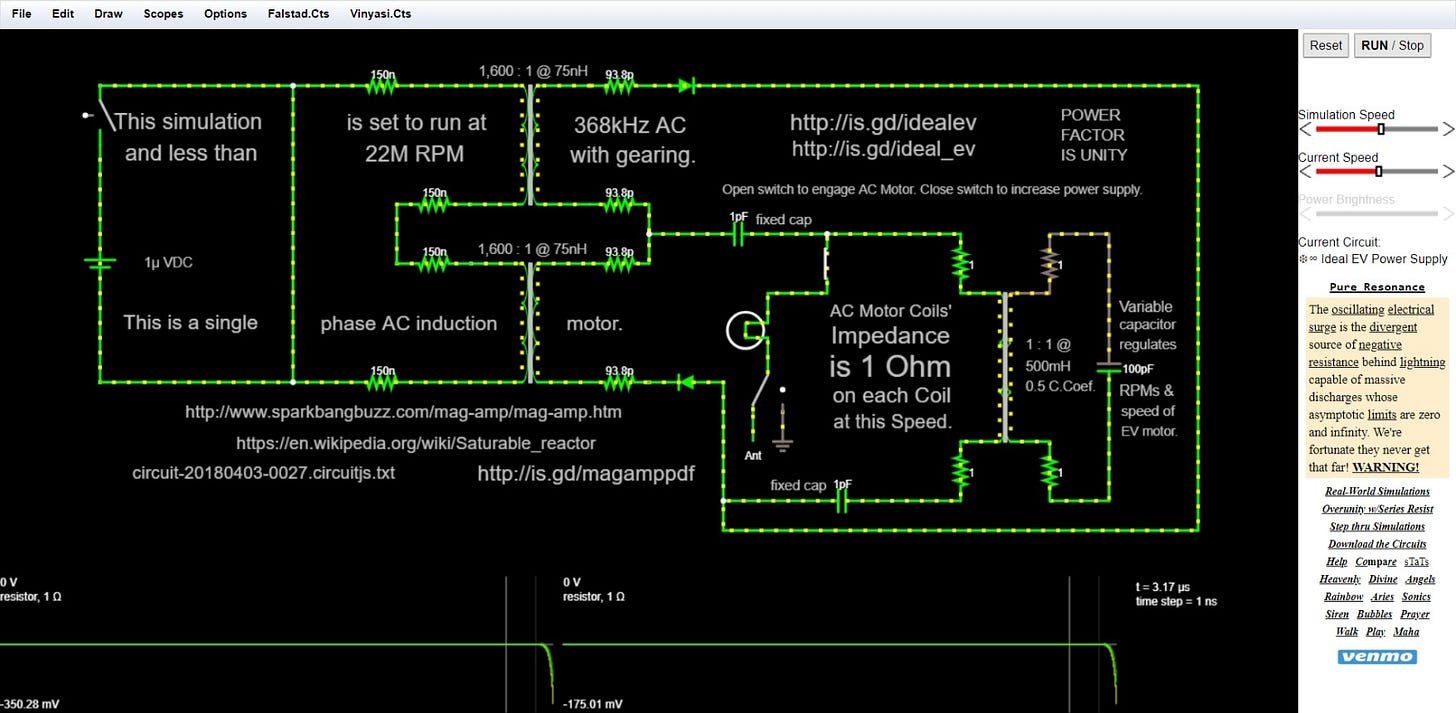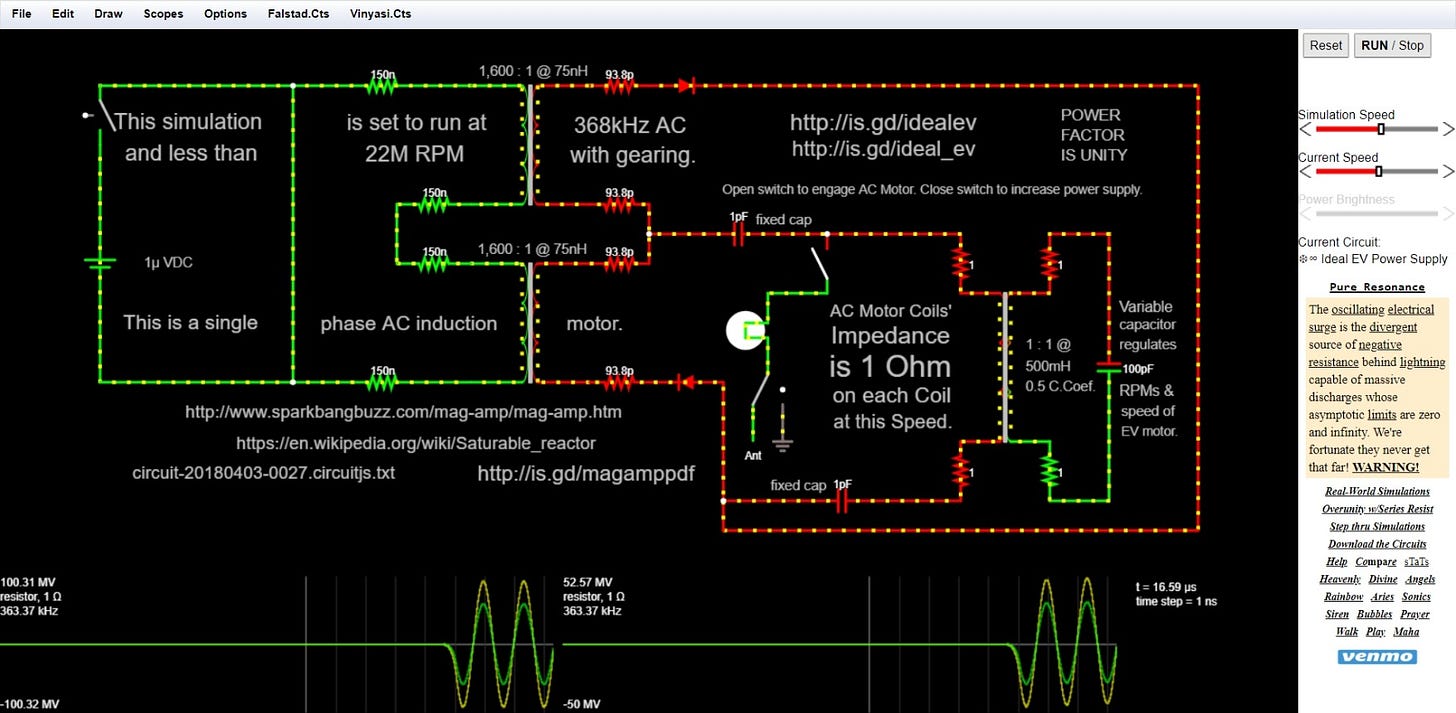Revisiting the Magnetic Amplifier, or MagAmp
When coils fail to saturate, overunity is a natural consequence.
Imagine a glass…we pour water into it and the water overflows at some point when the glass becomes full. But what if the glass should never become full? What if the glass has an infinite capacity for absorbing water and never reaching a limit of saturation?1
This is what we try to engineer into the designs of an overunity circuit: is a condition in which coils are incapable of saturation.
There may be more than one way to accomplish this. But the end result will always be the same, that…
The coil (in question) never absorbs anything. Instead, the energy bounces off of it like light bouncing off of a mirror in which the mirror is assumed to have 100% reflectivity and zero absorption of the energy of the light-beam. Like this, a coil which is incapable of saturation never absorbs the energy in the first place! Consequently, we have not defeated the Lenz Law. We have simply gone around it!
In contradistinction to this scenario, the conventional scenario is one in which a coil (that is not saturated) will absorb the energy up until the point of saturation and then leak out (or pass the buck so to speak of) the excess energy which it cannot absorb any further. This is a conventional description of the behavior of coils in general.
But if a coil is already saturated, the conventional wisdom expects that the additional energy which the coil receives will create a spillage although it's usually not described that way. It's usually described as being a leakage. Or in the alternative, it is described as being an incapacity or an impossibility for two or more coils in a transformer situation to pass energy between them. Nonetheless, the situation is the same in which the coils have become fully saturated.
The difference (here) is that the discharge is mistaken to be a leakage (or mistaken to be a lack of absorption) which will involve a time-lag in which the coil has a chance to decide whether or not it can accept any more energy. This time-lag indicates that the coil has become saturated, and the energy is not reflecting off of the coil but is delivered to the coil in a manner in which the coil gets to decide whether or not it can absorb any more energy.
But in the scenario that I have described at the opening of this discussion, the coil does not get an opportunity to decide whether or not it can absorb any more energy, because that decision has been made for the coil (on behalf of the coil) without involving the coil in the process of making that decision - because the energy is delivered to the coil in such a way that the coil will never have the opportunity to make that decision. The energy will decide on behalf of the coil to bounce off of the coil before the coil gets a chance to decide whether or not to absorb and accept the energy.
The implication is that we are not bypassing anything (such as Lenz Law). We simply have an alternative to Lenz Law in which this law does not describe the entire situation; nor all the options available; because the Lenz Law only deals with specific circumstances that we assume to be the case all the time when they are not.
In the case of the simulator of Paul Falstad, this condition (of the non-saturability2 of his transformer3 coils) has already been programmed into those specific types of coils without justifying how it came to be that way as if some magical wand had made it happen without a cause - an effect without a causation - to justify the result.
To take advantage of this condition, in the simulation, below, required an additional feature in which the inductance of the magnetic amplifying coils had to be reduced down into the range of nanohenries in order to prevent their saturation during the simulator’s initial runtime when it matters most. Otherwise, if I had waited too long by allowing the coils to have a much larger inductance, then entropy would have taken over and would have prevented their contribution to a condition of overunity.
By the way, by definition, the coefficient of performance for overunity is greater than 100% (unlike efficiency which cannot surpass 100%).4
We don't have a definition for the coefficient of performance for electrical overunity. So let me provide one…
Overunity is a coefficient of performance which is greater than one per unit of time since the accumulation of imaginary power is measured as a “rate” which can only be appreciated within the context of a specific framework of time.
This rate of accumulation can vary as much as dozens of millions of seconds versus nanoseconds and anywhere in between. It can also be instantaneous without any time frame.
This rate of accumulation can also accelerate (and usually does) at an exponential rate due to the contribution of the acceleration of the reactive impedance which is fueling this accumulation and production of imaginary power.
Unlike energy, which must conform to its conservation, imaginary power is not energy with the consequence that it does not conform to energy conservation.5
This is due to the fact that imaginary power is not kinetic energy; it is a potential form of energy born of another potential form of energy called: electrical or magnetic reactance.
This is why imaginary power can accelerate its accumulation (within a framework of time), because reactance is also a potential form of energy; reactance can also become modified and accelerate its rate of modification, such as: the continuous elevation of the parasitic oscillation which is driving the accumulation and production of imaginary power.
This continuous elevation of the parasitic oscillation of the accumulation and production of imaginary power increases the rate at which imaginary power is produced. And since imaginary power is lossless, it cannot be dissipated; it must accumulate!
But the moment imaginary power passes through a simple resistance, it converts itself into real power. Voila! We have now superseded the conservation of energy by performing a quarterback end-run (so to speak) bypassing The Law of Conservation by not engaging energy, namely: kinetic energy - has been avoided in the production of the potentiality of imaginary power.
Outside of the world of Paul Falstad's simulator, the SPICE family of simulators requires that you do something else in the extreme to make this scenario come about. And that is to…
Separate the phase of current from the phase of voltage by 1/2 cycle, namely 180° of separation between these two phases.
When this extreme condition of phase separation occurs, the energy is not traveling anymore, because it arises everywhere simultaneously. Thus, there is nothing to be absorbed nor discharged when the energetic waveforms occur everywhere at the same time rather than moving from place to place within a circuit. Thus, there is no time-lag and nothing for the coils to decide as to whether or not to absorb the energy or discard it as a leakage.
These scenarios can be simulated in theory if not built in practice. It won't be easy; but that doesn't mean it's impossible.
Despite engaging the hazards of simulating the real world and risking not getting the same results in the simulation as what convention will provide us, I'm going to proceed (ahead) anyway and simulate a circuit that was designed by a fellow by the name of Nyle Steiner. It's a superb variation on the magnetic amplifier.6
Here is a schematic of his final version.7
Here is some background material on the subject of magnetic amplifiers.8 9
And here is my simulation of the schematic, above…
Figure 1 - Surge mode.
Figure 2 - Dissipation mode.
This simulation may be found here…
https://vinyasi.info/ne?startCircuit=ideal-ev.txt
Shortened to…
Or…
And on Paul Falstad’s website…
Figure 3 - Dissipation mode hosted at Paul Falstad’s simulator (and the originator of this type of simulator).
Surf to…
It’s worthy of merit to reflect10 upon the Transforming Generator11 of Jim Murray since his device may be the key to understanding how to build an “ideal” transformer.12
Synopsis of Extending the Range of Electric Vehicles by Maximizing their Amp-Hours. (vinyasi.info) PDF The full text of this book is available on Amazon (y en Español).
Question on Quora: What is the difference between efficiency and COP?
Homemade Magnetic Amplifiers - webpage
MagAmp with Two Diodes - schematic
Saturable reactor - Wikipedia
http://is.gd/magamppdf > > > Magnetic Amplifiers, Principles and Applications, by Paul Mali, 1960, John F. Rider Publisher, Inc., New York, 110 pages. (archive org)




